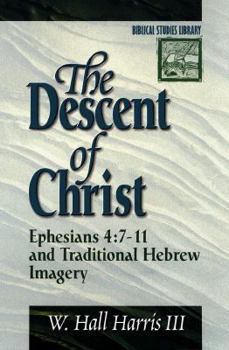The Descent of Christ: Ephesians 4:7-11 and Traditional Hebrew Imagery
Select Format
Select Condition 
Book Overview
This volume examines early Jewish and Christian imagery to demonstrate that the most probable interpretation of Christ's descent in Ephesians 4:9-10 refers to the descent of the Spirit at Pentecost... This description may be from another edition of this product.
Format:Paperback
Language:English
ISBN:080102191X
ISBN13:9780801021916
Release Date:January 1998
Publisher:Baker Publishing Group (MI)
Length:256 Pages
Weight:0.95 lbs.
Dimensions:0.8" x 6.0" x 9.1"
Age Range:18 years and up
Grade Range:Postsecondary and higher
Customer Reviews
1 rating
Where Did Christ Descend To?
Published by Thriftbooks.com User , 24 years ago
This book is a thorough and well researched analysis of the issues relating to the "descent of Christ". It looks at the questions relating to where and when Christ descended. The author approaches this by first looking at the various historical views. He shows how the early church fathers, the Reformers, and up to more modern scholarship have differed widely on their interpretation of Ephesians 4:7-11. He explores the main views - 1) The traditional view of Christ descending into Hell (as victor)after His death on the cross and then ascending to Heaven; and another common view - 2) Christ descending from Heaven to earth in His incarnation. He then spends most of the book developing another view (which does have some limited earlier support) which suggests that the relationship of Eph. 4:7-11 to Psalm 68 and the shorter reading of Eph 4 shows that these verses explain Christ's descent in His Spirit at Pentecost (Acts 2). This is then followed by His "ascent" to Heaven. From this view, he ties in the giving of gifts in Eph 4 to the giving of Spiritual gifts at Pentecost. The author presents a strong case for this view by looking at the historical evidence, manuscript evidence for the shorter reading (which supports Christ's descent occuring after His ascent to Heaven), early rabbinic literature, the Targums, the contextual evidence in Ephesians and in Psalms 68, and the grammatical evidence relating to the genetive case in Eph. 4.There were two main issues of possible contention that struck me: 1.)The author provides a logical case for the shorter reading based on the manuscript evidence. He follows, a prevelant modern view, which places more credibility to the older texts and states that the majority of the manuscripts and the "later texts" probably had additions to them. (i.e. These other "later" texts would support the "traditional view" of Christ's descent into the "underworld" and not the author's view.) Allthough this is common reasoning in modern textual criticism (i.e. Aland), I did not fully agree with this approach. I believe that there is more credibility to the view that the majority of the manuscripts (as opposed to the author's emphasis on the few older manuscripts), lectionaries, and quotes from the early church fathers present themselves as being more closer to the "original" texts. This view would clearly support the more "traditional" view and not the view that the author presents. But this is subject to debate among various scholars who hold various views on this subject. 2.)Another area of contention was the issue of the auther spending a great deal of time looking at the Targums, early rabbinic literature..etc, in building his case (particulary with regard to Psalm 68). Even though this research is necessary for this topic, it left me thinking at certain points that the author was presenting a case showing Ephesians 4;7-11 as not being inspired from God but rather it was i






